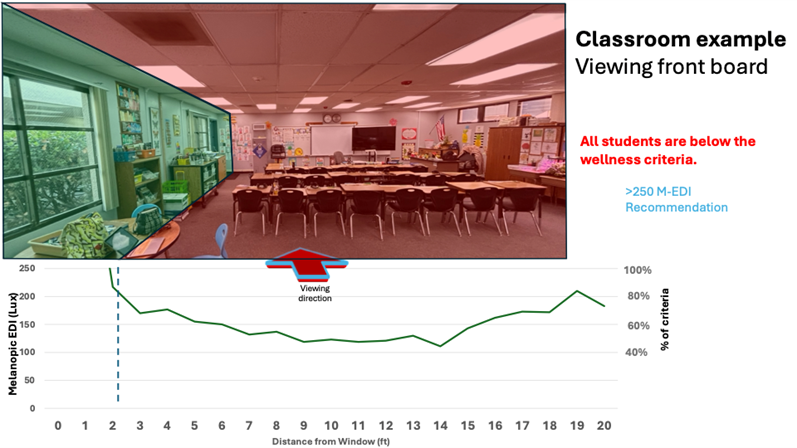Respected American company BIOS Lighting, which has long focused on the development of lighting that supports circadian health, confirms in a recent article what we at Spectrasol have been emphasizing for years: the quality of lighting in school classrooms can significantly contribute to improving students’ health, cognitive function, and performance.
It’s not just about light intensity – the spectrum matters
The modern approach to evaluating light no longer relies solely on photopic illuminance measured in lux, but also on so-called melanopic illuminance (melanopic EDI, from melanopic equivalent daylight illuminance), which considers whether the light contains enough cyan spectral content (around 480 nm) that activates the photopigment melanopsin and helps the body regulate its internal clock between alertness and rest.
Exposure to the right kind of light affects attention, mood, and academic performance
Research mentioned in the BIOS article shows that improving light exposure (especially through natural light or a high-quality substitute) can lead to up to 20% faster progress in math and 26% in reading, up to 20% improvement in academic results related to higher window-to-floor area ratios, and up to 36% increase in reading fluency with lighting of higher correlated color temperature (CCT) and brightness. However, we must not forget that CCT is not an indicator of the biological effectiveness of lighting—it is always important to understand the spectral composition of the lighting. We can think of it like a balanced diet—just as carbohydrates, proteins, and fats each have their place in nutrition, the cyan and red spectral components are essential in spectrally optimized lighting.
The problem in today’s classrooms: a lack of biologically effective light
Most schools today rely on standard LED lighting combined with natural daylight from windows. However, daylight intensity decreases rapidly with distance, and from the perspective of biological effectiveness, the recommended 250 melanopic lux (M-EDI) during the day, as per current CIE RP-46-23 standards, is far from achieved. This is confirmed by a case study conducted at noon in a classroom in Southern California. It was found that desks near windows were sufficiently lit, with an average photopic illuminance of 1300 lx. At a distance of 10 feet (about 3 meters) from the windows and in most of the room, the intensity dropped to just 344 lx. From a melanopic illuminance perspective, no workstation was adequately lit. Melanopic illuminance (M-EDI) takes into account radiation content in the cyan spectral band. A lack of this light leads to overall reduced cognitive performance in students, and they may be less focused and attentive. The case study found that the most disadvantaged children were those seated in the middle of the classroom. 70% of students were exposed to less than 70% of the recommended melanopic light level, and students in the center were exposed to only 60% of the minimum recommended level. Overall, the classroom’s melanopic illuminance would be rated a “C,” which is inadequate for supporting learning and health.
So even modern classrooms with large windows and new LED lighting, according to BIOS, can lead to a so-called circadian deficit—a state where the light fails to provide the body with enough signals for alertness and focus.
The authors of the study comment on this finding: “Even classrooms with modern LED lighting and plenty of windows may not provide the right type and amount of light, leading students into a circadian deficit – much like trying to take a test without studying the material.”
The metaphor aptly captures the importance of melanopic light
BIOS compares the melanopic dose of light to fuel for the brain, likening it to going into an exam unprepared—which most people have probably experienced at some point. But as the saying goes, the world favors the prepared, so why not use the full potential of LED technology to benefit both students and teachers?
The conclusion from BIOS is clear: If we want students to shine in their performance, the light in their classrooms must shine too. It’s not enough to have technologically equipped classrooms—we must build environments that support not only health but also alertness, mood, and cognitive performance. This can be achieved by applying circadian lighting that shines sufficiently in every part of the classroom and has a spectral composition as close as possible to natural sunlight.
We fully agree with the study authors’ conclusion: “If we want students to achieve outstanding academic results, we must ensure their classrooms get an A+ in lighting.”
This is why we are committed to maximizing the implementation of full-spectrum lighting in Czech classrooms and lecture halls.
Mgr. Tereza Ulrichová, Spectrasol
Source: Bright Students – Dark Classrooms – Why Healthier School Lighting Matters
Translated using AI


